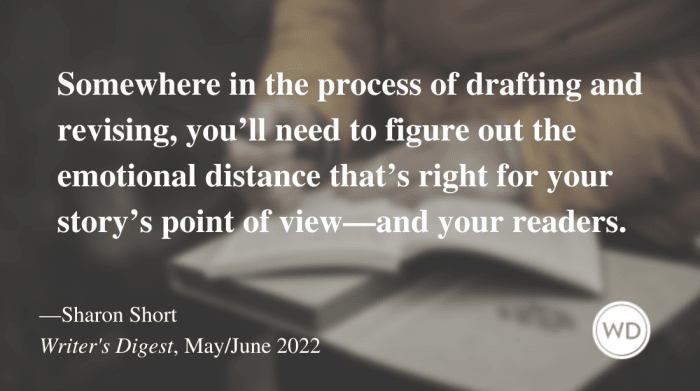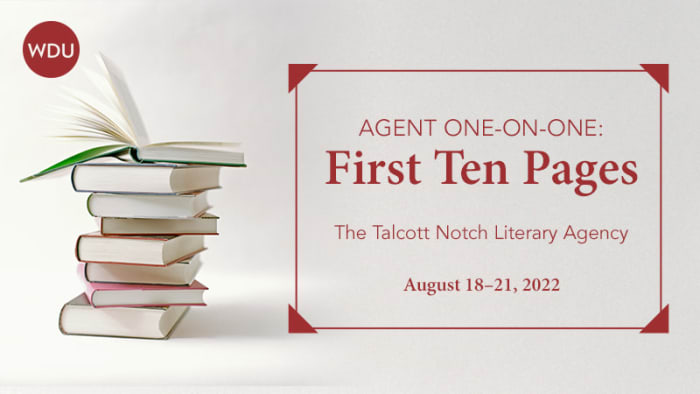Just how “into” your narrator’s head and heart do you want your readers to be? Do you want them to feel emotionally embedded with your narrator(s)? Or observe your characters’ experiences from afar? What emotional distance (close, far, or a mix) should you strike to achieve the best point of view for your story, novel, or memoir?
The answer, of course, depends on the type of story you’re telling as well as the experience you want your readers to have.
Luckily, you don’t need to know the answer before you begin writing—though it’s fine if you do. Somewhere in the process of drafting and revising, you’ll need to figure out the emotional distance that’s right for your story’s point of view (POV)—and your readers.
Deep POV—or Not?
A common pearl of wisdom is first person is more personal and immediate than third or omniscient—after all, the narrator is telling their story directly to the reader.
Consider this example:
I had to stay late for work, and as I was driving home, I wondered whether mac ’n’ cheese from a box would be OK for dinner, and I hoped that tonight I could finally get my 12-year-old daughter, Stacy, to open up to me. I was distracted and didn’t notice the pickup truck slowing down in front of me until it was too late and I rear-ended it.
Hmm. This feels a bit flat and distant, doesn’t it? The use of linking verbs (“was”), past progressive tense (“was driving”), and verbs that describe emotional and mental processes (“wondered,” “hoped,” also known as filter words) all hold the reader at bay.
Revise into what’s often called “deep POV” with active verbs and emotions to pull your readers into your narrator’s head and heart:
At first, I relaxed as I drove home; traffic was light, an unexpected boon of working late on another set of expense ledgers. But that also meant dinner would be late—again. Would everyone be OK with mac ’n’ cheese—again? Maybe I could get Stacy to help me—she always opens up when we’re doing a task together. I’d rather hear her prattle on about seventh-grade drama than worry about the water heater repair bill … Boom! Oh, crap. I hit the back of the pickup truck in front of me. If only I could stay focused on what’s right in front of me—whether ledgers or red brake lights.
Same information and then some—we know more about the narrator’s relationship with her daughter and financial worries, get a sense of her personality, and are right there with her when she rear-ends the truck.
This works just as well with third person:
At first, Donna relaxed as she drove home; traffic was light, an unexpected boon of working late on another set of expense ledgers. But that also meant dinner would be late—again. Would everyone be OK with mac ’n’ cheese—again? Maybe she could get Stacy’s help—the kid always opened up when they did a task together—and Donna would rather hear her daughter prattle on about seventh-grade drama than …
Notice how this deep POV and third person combination feels more distant than the deep POV and first person combination, but a lot closer than the initial example of first person.
But what if you want the reader to feel distant from Donna? Perhaps she’s a stiff, uptight character who doesn’t let anyone easily into her feelings. That’s fine—but it doesn’t mean you need to revert to verbs and filter words that describe, rather than show, experience. A less distracting way to create distance is to use active verbs, eliminate immediate thoughts and feelings, and stick to the facts of the narrator’s situation:
Reviewing another set of expense ledgers meant I left work late, but by then, traffic was light. Dinner would be late. Mac ’n’ cheese would be sufficient. Stacy could help make it. That would mean listening to the kid talk about seventh-grade drama. Suddenly, I crashed into the back of the pickup truck in front of me …
In the next of this three-part series on POV, I’ll explore the use of time in influencing both emotional distance as well as the overall POV of your work.

Finding the Proper Emotional Distance as a Writer
Every writer I know finds that being a writer is an emotional experience. Oh, we all try to be practical when talking about our experiences in public—focusing on craft techniques or business practices.
But when talking with trusted writer friends, we admit writing is an emotional endeavor—both as we create, and as we put our work out into the world.
While creating, you might get so into your work that the characters and situations become real. I’ve both burst out crying while writing a particularly moving scene and laughed aloud at my characters’ hijinks. (I’ve had family members catch me in such moments and ask, with some worry, for reassurance that I do know I’ve made up these characters and their situations. Well, sure. But, that’s beside the point. They feel real to us!)
That’s a great kind of emotional closeness to your work. It’s part of the joy of creation, after all, and though experiencing this as you write won’t ensure that every reader will feel the same way, it surely shows you’re on the path to creating something that is visceral and authentic.
On the other hand, when it’s time to revise, emotional distance becomes your ally. That hilarious scene that had you in stitches as you wrote it? If it’s slowing the pace of your story, it may need to be shortened—or even cut altogether. (But save it in a different file! Outtakes can be bonus material for readers in the future, or worked into new pieces.)
Then, dear writer friend, there’s the emotion of putting our work out into the world—perhaps sharing it with a trusted writer group, or submitting to agents or editors, or having it published for readers to enjoy (or, alas, sometimes not.)
Depending on our personalities and the reactions our work receives, emotions can run the gamut from joy and excitement (woo hoo, I have a request for my writing or my writing group loves my new scene!), to despair (I’ll never find a home for this story), to anger (how could a reviewer or writing group member say that about my work?).
Let yourself process all of those emotions but discipline yourself to hold back on expressing them. (Well, except if you have great news. That you can shout from the rooftops!)
Remember that setbacks are temporary. Not every piece of writing will please every reader; you’re not writing to please everyone anyway. Remind yourself that if you receive a pass on your work that it’s the work that’s being rejected—not you.
The writing journey has plenty of highs and lows, so relishing and celebrating the moments that feel great helps build you up so it’s easier to survive—and even grow from—the moments that don’t feel great.
Through it all, offer yourself grace. Creating anything is hard, so give yourself a hug just for being awesome enough to engage in the practice of writing.


